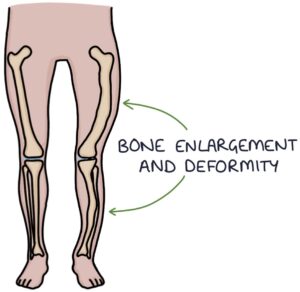Paget’s disease of bone involves excessive bone turnover (reabsorption and formation) due to increased osteoclast and osteoblast activity. The excessive turnover is not coordinated, leading to patchy areas of high density (sclerosis) and low density (lysis). The result is enlarged and misshapen bones, structural problems and an increased risk of pathological fractures. It particularly affects the axial skeleton (the bones of the head and spine).
The cause is unknown. It typically affects older adults.

Presentation
Patients may be asymptomatic (diagnosed incidentally on an x-ray), or present with:
- Bone pain
- Bone deformity
- Fractures
- Hearing loss
Investigations
X-ray findings include:
- Bone enlargement and deformity
- Osteoporosis circumscripta (well-defined osteolytic lesions that appear less dense compared with normal bone)
- Cotton wool appearance of the skull (poorly defined patchy areas of increased and decreased density)
- V-shaped osteolytic defects in the long bones
Blood tests include:
- Raised alkaline phosphatase
- Normal calcium
- Normal phosphate
Management
Bisphosphonates are the main treatment. They are generally very effective. They interfere with osteoclast activity and restore normal bone metabolism. They improve symptoms and prevent further abnormal bone changes.
Other measures include:
- Calcitonin is a treatment option where bisphosphonates are unsuitable
- Analgesia (e.g., NSAIDs) for bone pain
- Calcium and vitamin D supplementation, if necessary
- Surgery is rarely required to treat fractures, severe deformities and arthritis
Monitoring involves checking the serum alkaline phosphatase (ALP) and reviewing symptoms. Effective treatment should normalise the ALP and eliminate symptoms.
Complications
The key complications to remember are:
- Hearing loss (if it affects the bones of the ear)
- Heart failure (due to hypervascularity of the abnormal bone)
- Osteosarcoma
- Spinal stenosis and spinal cord compression
Osteosarcoma is a type of bone cancer with a poor prognosis. It is rare complication of Paget’s. It presents with focal bone pain, bone swelling or pathological fractures.
Spinal stenosis may occur where deformity in the spine leads to spinal canal narrowing. Pressure on the spinal nerves can cause neurological signs and symptoms. Spinal stenosis is diagnosed with an MRI scan. It may be treated effectively with bisphosphonates. Surgical intervention may be necessary.
Last updated September 2023
Now, head over to members.zerotofinals.com and test your knowledge of this content. Testing yourself helps identify what you missed and strengthens your understanding and retention.

